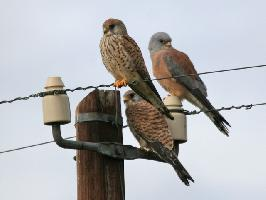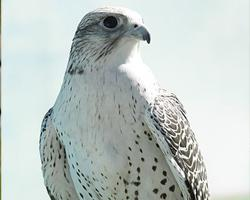
Poids et mesures
| Longueur | de 35 à 50 cm |
|---|---|
| Poids | de 500 à 1500 g |
| Envergure des ailes | de 85 à 115 cm |
Statut de conservation
| Menacé |
Description de l'animal
The Peregrine Falcon (Falco peregrinus), often heralded as the world's fastest bird, is a raptor of unparalleled speed and agility. With a cosmopolitan distribution, this bird of prey is found on all continents except Antarctica, showcasing its remarkable adaptability to diverse environments. The species exhibits a wide variety of plumage patterns, although typically, adults possess a blue-grey back, barred white underparts, and a black head with distinctive malar stripes.One of the most awe-inspiring features of the Peregrine Falcon is its hunting strategy, characterized by high-altitude stoops. From heights of up to 3,000 meters (10,000 feet), the falcon dives at speeds over 320 km/h (200 mph), striking prey mid-air with a lethal combination of speed and power. This spectacular maneuver not only demonstrates the falcon's physical capabilities but also its keen eyesight, essential for spotting prey from great distances.
The Peregrine Falcon's diet is primarily composed of medium-sized birds, such as doves, waterfowl, and songbirds. However, its diet can vary widely depending on its geographical location, including small mammals, reptiles, and even insects. This adaptability in feeding habits has contributed to its success as a species across varied habitats, from urban skyscrapers to remote mountain ranges.
Breeding behavior of the Peregrine Falcon is as fascinating as its hunting. The species is known to mate for life, with pairs returning to the same nesting sites year after year. Nests, or eyries, are typically located on high cliff faces or, in urban environments, tall buildings. This preference for lofty nesting sites reduces the risk of predation and provides a wide vantage point for hunting. Female falcons, or falcons, lay a clutch of 3 to 4 eggs, which are incubated primarily by the female while the male hunts for food for both of them.
Conservation efforts for the Peregrine Falcon have been a remarkable success story. In the mid-20th century, populations suffered drastic declines due to pesticide poisoning, particularly from DDT. However, through bans on harmful pesticides, captive breeding programs, and legal protection, the Peregrine Falcon has made a significant recovery and is now considered to be of Least Concern by the International Union for Conservation of Nature (IUCN).
Today, the Peregrine Falcon serves as a symbol of conservation success and continues to captivate bird enthusiasts and the general public alike with its breathtaking speed, beauty, and resilience. Its presence across the globe serves as a reminder of nature's adaptability and the importance of human efforts in preserving our planet's biodiversity.
Animaux similaires
Nouvelles photos d'animaux
Top 10 des animaux
- Dolphin gull (Leucophaeus scoresbii)
- Diana monkey (Cercopithecus diana)
- Moustached guenon (Cercopithecus cephus)
- Galápagos tortoise (Geochelone nigra complex)
- Japanese macaque (Macaca fuscata)
- Stone loach (Barbatula barbatula)
- Russian tortoise (Testudo horsfieldii)
- Greek tortoise (Testudo graeca)
- Common flying dragon (Draco volans)
- Vendace (Coregonus albula)


